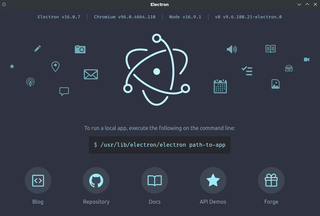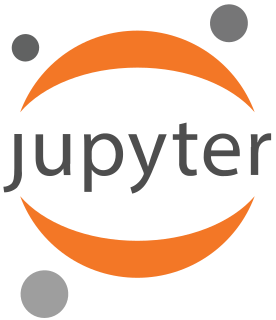A collaborative real-time editor is a type of collaborative software or web application which enables real-time collaborative editing, simultaneous editing, or live editing of the same digital document, computer file or cloud-stored data – such as an online spreadsheet, word processing document, database or presentation – at the same time by different users on different computers or mobile devices, with automatic and nearly instantaneous merging of their edits.
A source-code-hosting facility is a file archive and web hosting facility for source code of software, documentation, web pages, and other works, accessible either publicly or privately. They are often used by open-source software projects and other multi-developer projects to maintain revision and version history, or version control. Many repositories provide a bug tracking system, and offer release management, mailing lists, and wiki-based project documentation. Software authors generally retain their copyright when software is posted to a code hosting facilities.

CKEditor is a WYSIWYG rich text editor which enables writing content directly inside of web pages or online applications. Its core code is written in JavaScript and it is developed by CKSource. CKEditor is available under open source and commercial licenses.
GitHub, Inc. is a provider of Internet hosting for software development and version control using Git. It offers the distributed version control and source code management (SCM) functionality of Git, plus its own features. It provides access control and several collaboration features such as bug tracking, feature requests, task management, continuous integration and wikis for every project. Headquartered in California, it has been a subsidiary of Microsoft since 2018.

Etherpad is an open-source, web-based collaborative real-time editor, allowing authors to simultaneously edit a text document, and see all of the participants' edits in real-time, with the ability to display each author's text in their own color. There is also a chat box in the sidebar to allow meta communication.

XML Notepad is an open-source XML editor written by Chris Lovett and published by Microsoft. The editor features incremental search in both tree and text views, drag/drop support, IntelliSense, find/replace with regular expressions and XPath expressions, and support for XInclude. The editor has good performance on large XML documents and has real time XML schema validation. The editor also features an HTML viewer for displaying XSLT transformation results and a built-in XML comparison tool.

OnlyOffice, stylized as ONLYOFFICE, is a free software office suite developed by Ascensio System SIA, a company headquartered in Riga, Latvia. It features online document editors, platform for document management, corporate communication, mail and project management tools.

Socket.IO is a JavaScript library for realtime web applications. It enables realtime, bi-directional communication between web clients and servers. It has two parts: a client-side library that runs in the browser, and a server-side library for Node.js. Both components have a nearly identical API. Like Node.js, it is event-driven.

The Windows Package Manager is a free and open-source package manager designed by Microsoft for Windows 10 and Windows 11. It consists of a command-line utility and a set of services for installing applications. ISVs can use it as a distribution channel for their software packages.

.NET is a free and open-source, managed computer software framework for Windows, Linux, and macOS operating systems. It is a cross-platform successor to .NET Framework. The project is primarily developed by Microsoft employees by way of the .NET Foundation, and released under the MIT License.

Visual Studio Code is a source-code editor made by Microsoft for Windows, Linux and macOS. Features include support for debugging, syntax highlighting, intelligent code completion, snippets, code refactoring, and embedded Git. Users can change the theme, keyboard shortcuts, preferences, and install extensions that add additional functionality.

The .NET Foundation is an organization incorporated on March 31, 2014, by Microsoft to improve open-source software development and collaboration around the .NET Framework. It was launched at the annual Build 2014 conference held by Microsoft. The foundation is license-agnostic, and projects that come to the foundation are free to choose any open-source license, as defined by the Open Source Initiative (OSI). The foundation uses GitHub to host the open-source projects it manages.

Electron is a free and open-source software framework developed and maintained by GitHub. It allows for the development of desktop GUI applications using web technologies: it combines the Chromium rendering engine and the Node.js runtime. It was originally built for Atom. Electron is the main GUI framework behind several open-source projects including Atom, GitHub Desktop, Light Table, Visual Studio Code, Evernote, WordPress Desktop, and Eclipse Theia.
The Open Neural Network Exchange (ONNX) [] is an open-source artificial intelligence ecosystem of technology companies and research organizations that establish open standards for representing machine learning algorithms and software tools to promote innovation and collaboration in the AI sector. ONNX is available on GitHub.

Project Jupyter is a project and community whose goal is to "develop open-source software, open-standards, and services for interactive computing across dozens of programming languages". It was spun off from IPython in 2014 by Fernando Pérez and Brian Granger. Project Jupyter's name is a reference to the three core programming languages supported by Jupyter, which are Julia, Python and R, and also a homage to Galileo's notebooks recording the discovery of the moons of Jupiter. Project Jupyter has developed and supported the interactive computing products Jupyter Notebook, JupyterHub, and JupyterLab. Jupyter is a NumFOCUS fiscally sponsored project.
Microsoft Docs is the library of technical documentation for end users, developers, and IT professionals who work with Microsoft products. The Microsoft Docs website provides technical specifications, conceptual articles, tutorials, guides, API references, code samples and other information related to Microsoft software and web services. Microsoft Docs was introduced in 2016 as a replacement of MSDN and TechNet libraries which previously hosted some of these materials.
Microsoft, a technology company historically known for its opposition to the open source software paradigm, turned to embrace the approach in the 2010s. From the 1970s through 2000s under CEOs Bill Gates and Steve Ballmer, Microsoft viewed the community creation and sharing of communal code, later to be known as free and open source software, as a threat to its business, and both executives spoke negatively against it. In the 2010s, as the industry turned towards cloud, embedded, and mobile computing—technologies powered by open source advances—CEO Satya Nadella led Microsoft towards open source adoption although Microsoft's traditional Windows business continued to grow throughout this period generating revenues of 26.8 billion in the third quarter of 2018, while Microsoft's Azure cloud revenues nearly doubled.

Windows Terminal is a multi-tabbed terminal emulator that Microsoft has developed for Windows 10 and later as a replacement for Windows Console. It can run any command-line app, including all Windows terminal emulators, in a separate tab. It is preconfigured to run Command Prompt, PowerShell, WSL, SSH, and Azure Cloud Shell Connector. Windows Terminal comes with its own rendering back-end; starting with version 1.11 on Windows 11, command-line apps can run using this newer back-end instead of the old Windows Console.











